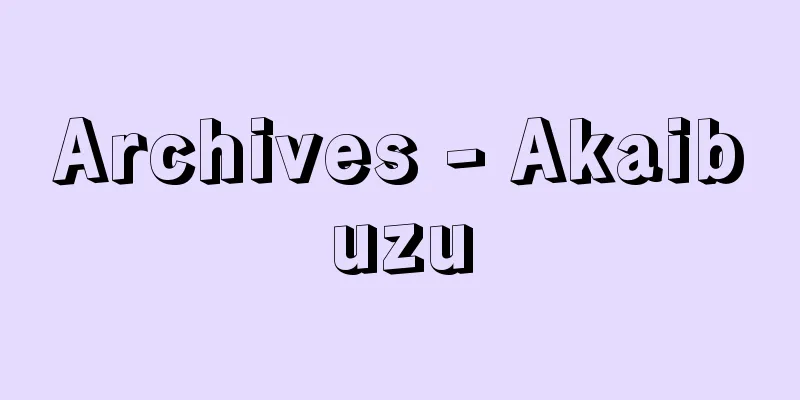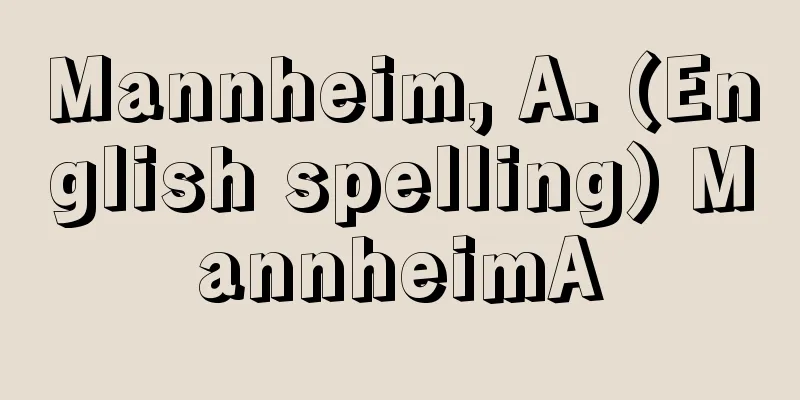Archives - Akaibuzu

|
According to the Archives Glossary (Osaka University Press, 1997) , archives can mean: 1) historical materials, documentary materials, 2) archives, 3) the Public Records and Archives Administration Office, and 4) "in computer terms..." Here, we will refer to 2) archives, that is, "a building or part of a building where historical materials are recorded and can be viewed and used," as a university archive. [history] The history of university archives began with medieval universities. Initially, prospectuses for the founding of universities, or documents and artifacts related to people involved in the founding were kept. In German-speaking countries, there are also examples of regional archives that preserve the historical materials of universities founded in the region, in addition to universities. At the University of Vienna (Austria), founded in 1365, a "university wooden box" containing legal documents was established in 1388, and these have been kept by successive presidents. In the 16th century, a "records office" was established, and documents of legal and historical importance began to be preserved. This is generally how it went, but there are also examples, such as Uppsala University (Sweden), where the archives were established in 1477, the same year as the university was founded. The founding of archives in the United States dates back to the formation of the American Historical Association (1884) . The Society of American Archivists was formed in 1936, and the Committee on University Archives was established as a subcommittee of this association in 1949. In addition to archives that handle materials for the entire university, there are also fields that have their own archives, such as the Langone Medical Center Archives at New York University (USA). An international organization related to archives is the International Council on Archives (ICA) , which was established in 1950 at the suggestion of UNESCO. In Japanese universities, commemorative publications were compiled at milestones such as the 50th anniversary of the founding of universities, but the materials collected at the time tended to be scattered or discarded after the publication, as was the case at the University of Tokyo. The Tohoku University Archives was established in 1963, and was one of the first national universities to have the name University Archives. After the publication of the 50-Year History of Tohoku University in 1960, the Tohoku University Memorial Archives Room was established for the purpose of preserving materials, and it became the forerunner of national university archives. Today, many universities have resource rooms and history rooms. At small and medium-sized single-discipline universities, the majority of the work of collecting and compiling materials for university history was handled by librarians who were graduates of the university, and was set up in a corner of the library. However, by the time of the publication of the 100-year history, there were cases where a separate room was set up. Kyoto University and Osaka University are examples of national universities that established archives, not directly related to the compilation of university history, in response to the enforcement of the Information Disclosure Act and the incorporation of national universities. The Kyoto University Archives was established in 2000 because it was deemed necessary to have an institution to preserve administrative documents whose retention periods had expired. At the same time, document preservation regulations and management records were also created. The activities and projects of the Archives are diverse. They include: 1) research and collection, 2) organization and preservation, 3) browsing and reference services, 4) compilation of related journals, 5) educational activities: offering courses on the history of the university with the aim of establishing the university's identity, 6) events: holding events and courses related to the history of the university, 7) exhibitions: permanent exhibitions and special exhibitions, 8) community exchange: holding lectures, exhibitions, symposiums, etc. in places related to the university. Recently, some archives have been made public online. There are also events that are co-sponsored, such as the special exhibition "The Dawn of Modern Japan and Private Law Schools" held in the Meiji University Museum Special Exhibition Room in 2014, which, in cooperation with the archives of Senshu, Chuo, Nihon, Meiji, and other universities, as well as Dokkyo Gakuen and Hosei University, focused on the Kanda student district and the legal code debates that unfolded over the implementation of the Civil Code and Commercial Code. The national organization for those involved in university history materials is the National Council of University History Materials, which was established in 1996. Its origins lie in the Tokyo Seminar of the University History Research Group in 1983. In 1988, the Kanto Region University History Liaison Council was established, which eventually merged with the West Japan Association of University History Professionals, which was established in 1990 in Western Japan. With regard to the training of professional archivists and the education of those currently working in the field, graduate school-level education has been attracting attention, and lectures and courses for training and retraining archival professionals are being held at universities and graduate schools throughout the country. Article 15, paragraph 3 of the Law on the Management of Public Records, etc. (Law No. 66 of 2009) states that the head of the National Archives of Japan, etc. must take the necessary measures to prevent the leakage of personal information (information about living individuals) if such information is recorded in specified historical public records, etc. This is also expected of archivists. [collection] The materials collected by the archives at present are administrative documents from the secretariat and each department that have passed their retention period, publications such as public relations and course guides, photographs and illustrations, digital materials, letters, documents, and notes from university personnel, etc. As for meeting minutes, in addition to minutes of faculty meetings and various other meetings, notes from attendees and other documents will be valuable materials for future generations, as they will provide information on the course of events that is difficult to understand from official records. Regarding administrative documents, etc., the principles of archiving materials are not fully communicated to each department within the university at large universities, and there is a possibility that they will be discarded, so each department within the university is required to thoroughly preserve materials. Kyoto University (Archives) has a note in Article 9 of the "Regulations for the Management of Administrative Documents at Kyoto University" that "Administrative documents whose retention period (if extended, the extended retention period) has expired shall be transferred to the Kyoto University Archives." There are few examples of such a system for transferring administrative documents within the university. It is essential that each university establishes a transfer system. In addition, universities are institutions of education and research. Therefore, it is desirable to strengthen the collection and preservation of materials related to education and research in the future. In addition to academic research results, supplementary teaching materials and student reports can be important testimonies that represent the times. During the university protests (conflicts) in the late 1960s, student flyers and posters were collected, and signboards were photographed and preserved. These collections are not only significant as the history of individual universities, but also materials related to the history of higher education, social history, cultural history, political history, and local history, and it is essential that they be preserved and made available to future generations. It is necessary to thoroughly establish selection criteria for what to keep and what to discard from the increasing number of materials every day. References: Japan University Archives, edited by the National Council of University History Materials, Kyoto University Press, 2005. References: Ogawa Chiyoko, Takahashi Minoru, and Onishi Ai (eds.), Encyclopedia of Archives, Osaka University Press, 2003. Source : Heibonsha "University Encyclopedia" About the University Encyclopedia Information |
|
アーカイブズとは,『文書館用語集』(大阪大学出版会,1997)によると①史料,記録史料,②文書館,③公文書記録管理局,④「コンピュータ用語では…」とある。ここでは②文書館,すなわち「史料が記録され,閲覧利用できる建物,または建物の一部」として,大学における文書館として扱う。 [歴史] 大学アーカイブズの歴史は,中世の大学に始まる。当初は大学設立の趣意書,あるいは創設に関わった人物にまつわる資料や遺物が保管されてきた。ドイツ語圏では,大学以外にも地域のアーカイブズで,当該地域に創設された大学の資史料等を保存している例もある。1365年創設のウィーン大学(オーストリア)では,1388年に法的文書を収めた「大学の木箱」が設けられ,歴代の学長たちが保管してきた。16世紀になると「記録所」が設けられ,法的,歴史的に重要な史料が保存されていくという経緯をたどっている。おおむねこのような流れをたどるが,スウェーデンのウプサラ大学(スウェーデン)のように,アーカイブズの設立が大学設立と同年の1477年という例もある。 アメリカ合衆国におけるアーカイブズ設立の発端は,アメリカ歴史学会の結成(1884年)にある。1936年に全米アーキビスト協会が結成され,1949年にはこの協会の一部会として大学アーカイブズ委員会が設けられた。大学全体の資料等を扱うアーカイブズとは別に,ニューヨーク大学(アメリカ)のランゴンメディカルセンターアーカイブズのように,独自にアーカイブズを持つ分野もある。アーカイブズ関係の国際団体としては,1950年にユネスコの提唱で設置されたICA(International Council on Archives:国際公文書館会議)がある。 日本の大学では,創立50年などの節目に記念誌編纂がなされたが,その際収集された資料等が,記念誌刊行後,東京大学などにみられたように,散逸あるいは廃棄される傾向にあった。国立大学としていち早くユニバーシティ・アーカイブズ(University Archives)の名称を持った東北大学史料館は1963年に設立された。1960年の『東北大学五十年史』刊行後,資料保存等の目的のために東北大学記念史料室が設立されたのに始まり,国立大学アーカイブズの先駆けとなった。今日では多くの大学が資料室や年史室を設けている。中小規模の単科大学では,大学史の資料収集と編纂の仕事の大半は,大学の卒業生である図書館員が担当し,図書館の一隅に設置されていた。しかし100年史などを刊行する頃には,独立した部屋を設けられた例もある。大学史編纂とは直接関わりなく,情報公開法の施行や国立大学法人化などを機に,アーカイブズを設けた国立大学の例が京都大学と大阪大学である。2000年設置の京都大学文書館は,保存期間満了の行政文書を保存する機関の設置が必要とみなされて設けられ,同時に文書の保存規程や管理簿の作成もなされた。 アーカイブズの事業,活動は多岐にわたる。①調査・収集,②整理・保存,③閲覧やレファレンスサービス,④関係紀要等の編纂,⑤教育活動:大学のアイデンティティ確立を目的とした,当該大学の歴史の授業科目の開講など,⑥イベント活動:大学史関係事業や講座の実施,⑦展示:常設展・企画展,⑧地域交流:大学ゆかりの地での講演・展覧会,シンポジウム等の実施などがある。昨今ではウェブ上での公開の例もある。共催で行われるイベントもあり,2014年に明治大学博物館特別展示室において開催された企画展「近代日本の幕開けと私立法律学校」では,専修,中央,日本,明治など各大学のアーカイブズのほか,獨協学園,法政大学の協力のもとに,神田学生街や民法・商法の施行をめぐって繰り広げられた法典論争を取りあげた。 大学史資料関係者の全国組織は,1996年発足の全国大学史資料協議会である。設立の発端は1983年の大学史研究会東京セミナーであった。1988年には関東地区大学史連絡協議会が設立され,西日本で1990年に発足した西日本大学史担当者会と合併するに至った。専門職としてのアーキビストの養成と現職者教育については,大学院レベルの教育が注目され,文書館専門職養成や再教育のための講義や講座が各地の大学や大学院で開かれている。公文書等の管理に関する法律(平成21年法律第66号)15条3項に,国立公文書館等の長は,特定歴史公文書等に個人情報(生存する個人に関する情報)が記録されている場合には,当該個人情報の漏洩の防止のために必要な措置を講じなければならないとある。アーキビストにも求められることであろう。 [コレクション] アーカイブズが収集する資料は,現状では事務局や各部局の行政文書のうち保存年限を経過したもの,広報や履修案内などの刊行物,写真や図版,デジタル資料,大学関係者の書簡,書類,メモなどである。会議録としては,教授会ほか各種会議の議事録に加えて,出席者のメモなど,公的な記録では分かり難い議事の経緯が,後世にとっては貴重な資料となる。行政文書等については,大規模大学ではアーカイブズの資料保存の原則が学内の各部署に十分に伝わらず,廃棄されてしまう可能性もあり,学内の各部署への資料保存への徹底が求められている。京都大学(アーカイブズ)は,「京都大学における行政文書の管理に関する規程」9条で,「保存期間(延長された場合にあっては,延長後の保存期間とする)が満了した行政文書は,京都大学文書館へ移管するものとする」と銘記している。このような学内行政文書を移管する仕組みをとっている例は少ない。各大学における移管システムの確立が肝要である。 加えて,大学は教育と研究の機関である。したがって,今後は教育・研究関連資料の収集と保存の強化が望まれる。学術研究成果のほか,授業の副教材,学生のレポートなどが時代を表す重要な証言となりうる。1960年代末の大学紛争闘争(紛争)の折には,学生側のチラシ,ポスターなどが収集され,立て看板なども写真撮影され保存された。これらのコレクションは,個別大学史としての意義だけではなく,高等教育史,社会史,文化史,政治史,郷土史に関わる資料であり,後世への保存と公開が肝要である。日々増加する資料のうち,何を残し,何を廃棄するか,選択基準を徹底する必要がある。 参考文献: 全国大学史資料協議会編『日本の大学アーカイヴズ』京都大学学術出版会,2005. 参考文献: 小川千代子,高橋実,大西愛編著『アーカイブ事典』大阪大学出版会,2003. 出典 平凡社「大学事典」大学事典について 情報 |
Recommend
Elle, A. - Elle
… [France] In France, Rodolphe Töpfer (1799-1846)...
Kingdom of Johor - Kingdom of Johor
A Malay kingdom in the southern part of the Malay ...
ūr (English spelling) ur
...This term is found in the Vedas as far back as...
Anjo
A city in the central and southern part of Aichi P...
Wassus - Wassus
...As can be seen from this example, the relation...
Anzaisho - Imperial residence
〘Noun〙 = Angu (temporary palace) ※Shoku Nihongi - ...
Epidendrum prismatocarpum (English spelling) Epidendrum prismatocarpum
…[Koichi Ejiri]. … *Some of the terminology that ...
Isoshi - Isoshi
…An optical element used to change the phase diff...
Jar - jar
It is also written as "bin". It is a ce...
yardangs
...The former is an erosion process that occurs w...
Ch'oe Sǔng‐no (English spelling)
927‐989 A politician from the Goryeo Dynasty, Kore...
Dodd, Charles Harold
Born: April 7, 1884. [Died] 1973 British New Testa...
Klerk, M.de (English spelling) KlerkMde
… Rietveld and Oud of the same group continued Be...
Hiraga Motoyoshi
A poet of the late Edo period. He was known by th...
Ripple - Ripple (English spelling)
A payment system operated by the US venture Ripple...









